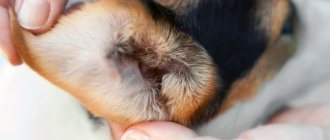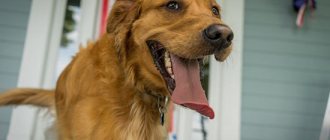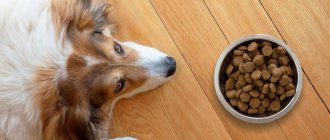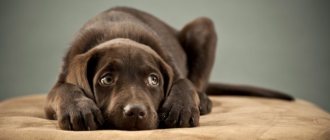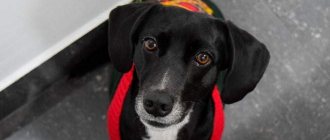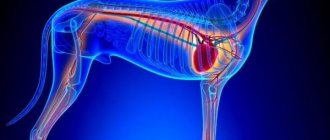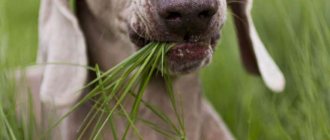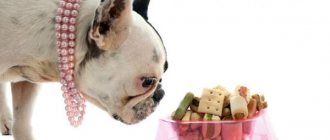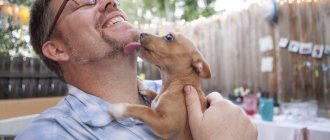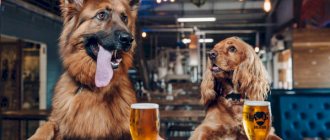If your dog constantly licks under its tail, the most likely cause is a blocked anal gland in your pet. In a physiologically healthy state, their cleansing occurs regularly with each bowel movement of the animal.
But with a sedentary lifestyle and improper feeding, this body function is disrupted and the dog needs the help of the owner. The presence of worms in the intestines can also cause discomfort to the four-legged animal, so taking antihelminthic drugs should be periodic.
Licking as a natural reflex
If you put a plate of delicious food in front of you, you will feel that saliva is quickly accumulating in your mouth and you will swallow it absolutely reflexively. When your dog smells food (and his sense of smell is stronger than yours), he produces more than just saliva. The work of all the mucous membranes of dogs is closely connected, saliva is released and the nose becomes more moist. Absolutely reflexively and without thinking, the dog swallows saliva and licks its nose so that its moist “shell” is renewed. The fact is that this mucous “lubricant” on the nose enhances the sense of smell in dogs.
Note! When a dog yawns, he often instinctively licks his nose. The pet may lick itself during sleep, since the activity of the mucous membranes is reduced, and the nose may dry out.
When your dog licks or smacks frequently, make sure he is not thirsty . When kept on commercial food, the dog should always have access to water, even when you are not at home. Thirst is very dangerous and painful, it is better to allocate a place for a large bowl of water, but be sure that the pet does not wake up to suffer. The water in the bowl needs to be changed daily, and in the hot season several times a day. It is important to thoroughly wash off the residue from the bowl. Make sure your dog is drinking enough water, as water refusal is a very serious and dangerous symptom.
Tip: If your pet doesn't drink much, offer him filtered water. Quadrupeds with weak kidneys or their ailments instinctively avoid consuming “dirty” water.
A dog may lick its face frequently due to stress, excitement, or impatience . This is the emotional side of the issue, which does not have much impact on the health of the ward. In a state of excitement, all body systems work more actively, so the dog often licks its nose and swallows saliva.
What does the smell from under the tail mean?
In healthy dogs, the smell of secretion is elusive to the human nose or is felt very, very weakly. But for his fellow humans he has a lot of useful information. What can this “personal” scent “tell” about?
- Age . The secretory fluid of puppies and dogs that have reached puberty does not have an individual odor. In this way, nature made sure that the animals remained invisible and their survival rate was higher.
- Physical ability and power . The composition of the secretion of small animals and large animals is different and, accordingly, has a different aroma.
- Health status . The smell from under the tail of a sick dog becomes abnormal and signals that this individual is weak. In the wild, she would have faced inevitable death from the claws and paws of stronger and healthier individuals. What can you do, natural selection.
Causes of blockage and cleaning
When the body does not work properly, the secretion becomes thick and does not go away on its own, causing anxiety to the animal. In this case, the dog licks under the tail, thus trying to relieve pain.
There are several reasons for blockage:
Read also: Why the ruble is pegged to the dollar
- a sedentary lifestyle leads to stagnation in the body, weakening muscles, both external and internal;
- feeding bones may cause internal damage to the intestines and rectum;
- external injuries, blows, bruises, bites;
- poor diet causing constipation or loose stools;
- disruption of the immune system;
- genetic predisposition, most often manifested in dogs of decorative breeds;
- infectious and bacteriological infections that cause disruption of the intestines and the body as a whole.
All this can lead to blockage of the glands, the impossibility of self-cleaning, which requires forced cleaning.
The procedure for clearing the anal sacs can be done either at a veterinary clinic or on your own by squeezing and physically removing secretions from the sinuses. It is important to monitor the blockage of the glands at the initial stage and take action, since the accumulation and thickening of the secretion can cause complications that will require long-term treatment.
When to contact a veterinarian
The problem with the anal glands is not terrible if it does not lead to inflammation. When a ward has a balanced menu and proper exercise, if he has not injured his anus during games, there is no need to remember the existence of sinuses.
But if the process has begun, purulent and watery discharge, swelling and a heavy odor appear, the pet is taken to the veterinarian. The dog often licks its tail; a specialist will figure out why. He will conduct an external examination, do an ultrasound of the abdominal cavity, and take urine, blood and stool tests to rule out helminths. A professional will also clean the glands.
Some individuals need the procedure once a year, others more often. If the owners are forced to squeeze out secretions from the glands every week, then it is more humane to remove the organ. Veterinarians carefully operate on the sufferers, and within a day they return to normal.
The dog licks its groin, becomes nervous, and whines - this may indicate a disruption in the natural process of self-cleaning of the anal glands. They produce an odorous enzyme that dogs use to mark their territory and attract individuals of the opposite sex. If a dog doesn’t walk much or has problems with bowel movements, then feces do not squeeze out secretions from the anal sacs. Stagnation of the substance leads to inflammation, suppuration, and abscess. The owner must help his dog cleanse the glands. When the disease is severely advanced, you should contact a veterinary clinic.
What to do if your dog has inflamed anal glands
The secretion contains many proteins and other elements that serve as an excellent substrate for the proliferation of bacteria. The more it accumulates, the more active and faster the inflammatory process will begin. If you notice signs of it, contact a specialist immediately. If it’s not too late, he will clean the anal sacs, process them, and then prescribe special suppositories (Proctosedyl, Ichthyol, etc.), which will have to be inserted into the dog’s butt.
It's done like this. Insert the candle and do not let it come out by pressing the anus with your fingers; after a minute the pet can be released. Small breeds do not require the entire dose of medication, so the candle must be inserted after cutting it.
If you miss the time, the bags may burst, and the purulent liquid will spread, finding a way out even through the skin. This process is called an abscess. With an abscess, a hole with erosive edges (similar to an ulcer) forms, through which a thick, purulent yellow substrate will ooze. The tissue around the fistula swells, and even large swelling is possible. The dog is worried and constantly tries to lick the wound. Here you cannot do without a veterinarian, since the glands still need to be cleaned, rinsed, and a drainage tube must be installed to drain the remaining pus.
It will take a long time to treat inflammation of the anal glands. You will also need to use anti-inflammatory suppositories, supplemented with antibiotic injections.
Types of the disease and the course of the disease, as well as possible complications
There are three types of the disease:
- The process of blockage of the anal glands. This is where it all begins. The secretion is not released naturally during bowel movements and accumulates. At this stage, itching and redness appear in the anus. A yellowish or transparent secretion begins to appear. The dog intensively scratches the affected area. Subsequently, the secretion becomes thicker, baldness in the anal area is observed, pustules also form on the inner side of the thigh, and pelvic paralysis occurs. Subsequently, the itching begins to cover an increasingly larger surface of the pet’s body, the secretion changes color and consistency, becoming darker and thicker.
- Inflammatory process. Suppuration occurs, and inflammation spreads from the gland itself to the surrounding tissues. If the ducts are not cleared at this stage, an abscess occurs.
- Fistula formation. Once mature, the abscess breaks out, resulting in the formation of a fistula in the area of the anal gland. During this period, the dog begins to refuse food, there is an increase in body temperature, lethargy and a depressive state. Surgical treatment is required, otherwise everything can end in death.
How to clean anal glands in dogs
Cleaning the anal glands should be done carefully!
Anal glands are also called anal sacs, and they are also called paraanal glands. The cleaning process itself is quite unpleasant, so many dog breeders turn to a veterinarian for this purpose. You can do it like this:
- Wear gloves and place the animal in a container where the liquid should drain. Ask an assistant to hold the pet, clasping it with your hands from the muzzle to the tail.
- Inspect the dog's rear, visually noting the pouches. After this, lift the tail up with one hand (not to the point of pain) - this will relieve tension from the perianal area, with the other, gently press on the swelling from the sides, bringing your fingers closer to the anus.
- The liquid is very disgusting in appearance and terribly smelling, it will flow out in a few seconds. It must be flushed down the drain immediately.
If the structure of the anal glands does not allow you to get rid of the secretion in such a simple way, then you will have to perform the operation in an even more unpleasant way.
- Lubricate your index finger with Vaseline or vegetable oil and insert it as gently as possible into the dog's anus. The finger should be held at a slight angle, pointing the phalanx towards the floor (as if from above).
- Feel for the gland, and grabbing it from the inside, help squeeze out the liquid with your thumb from the outside, moving your fingers towards the anus.
Nature gave abilities, and man found application
There is a theory that a dog's memory stores all the "individual dog scents" its nose has ever smelled. It is impossible to find an exact confirmation or refutation of this hypothesis, however, situations are not uncommon when a pet, meeting a “childhood friend,” begins to communicate with him as with an old friend.
The habit of animals, when they meet, to bury themselves under the tail of their fellow animals prompted people to use it for diagnostic purposes. Dogs quite often make it clear to the owners of their companion that their pet is unwell. Laboratory studies were carried out that confirmed the effectiveness of this innovative diagnostic method.
In 2004, the results of a study appeared in the pages of the British Medical Journal proving that in cancer, the human body produces odorous substances, and the sensitive sense of smell of dogs allows them to sense it. These data created a sensation in medical circles and immediately gained recognition at the global level.
Belencon
Editor of the section “Endocrinology”
Chief physician of the Bely Klyk branch in Strogin, head of the diagnostic and treatment department of the Bely Klyk veterinary clinics.
Born in the Far East on November 14, 1975. In 1992, he moved with his family to Moscow, where he graduated from school. In 1993, he entered the Moscow State University of Applied Biotechnology at the Veterinary and Sanitary Faculty, from which he graduated with honors in 1998.
On January 7, 1999, he began working at the newly opened Bely Klyk clinic as a veterinary assistant, a year later he began to conduct independent appointments, and was eventually appointed head physician of the clinic’s branch in Strogin. His interest in veterinary endocrinology, having once arisen, does not fade to this day. In this area, Belenson achieved considerable success. It was possible to establish the diagnosis of common endocrine diseases of dogs and cats, to gain experience in the treatment of diabetes mellitus, Cushing's syndrome, hypothyroidism, Addison's disease and some other endocrine pathologies.
In addition to his work as head physician and scientific activities, Maxim Mikhailovich generously shares his knowledge and accumulated experience. The blog, accessible to both professionals and ordinary pet owners, publishes articles on the diagnosis and treatment of the most common endocrine disorders in dogs and cats. Participates in the preparation of master classes. He gives lectures at various events dedicated to advanced training of veterinarians, and takes part in the annual Moscow Veterinary Congress as a speaker.
Sexual desire
The introduction of any dog follows the same scenario. The first is the meeting of noses, the second is a shoulder bump or contact with the sides, and then sniffing under the tail. You may not have noticed the first two stages, but if you watch, you will be convinced of the truth of this theory. This is an iron rule; all four-legged animals follow it, regardless of age and gender. There is only one exception - sexual desire and aggression for the same reason.
If the situation does not seem tense to the male dog, when he meets a female dog in heat, he will follow the usual algorithm, but if there are competitors nearby... the stakes are too high. The male will try to quickly dive under the bitch’s tail; the smell will give information about whether the female is ready for mating. In the process of obtaining information, the impudent dog may be attacked by another male, even without an introduction or greeting.
In the world of mature dogs, arrogant sniffing under the tail is fraught with a slap in the face. For example, in a pack of wolves, only the leader and the alpha female have the right to sniff everyone. If a puppy or young wolf dares to poke his nose into, for example, the alpha female without permission... he will be punished by the she-wolf, the leader, and those who were simply nearby.
Pack hierarchy is a science that cannot be known, but can be understood. To avoid trouble, do not allow a puppy or young dog to brazenly sniff at obviously older dogs. When meeting new friends, hold your pet by the leash and pull him back if he is being too persistent. Sooner or later, your pet will run into trouble (this happens to everyone, there are no exceptions) and gain invaluable life experience. Your task is to make sure that the puppy gets into training spanking when he is ready. Please note that when training young and especially unfamiliar dogs, adult dogs do not make special concessions. Simply put, if your Pug is attracted to your Rottweiler, there is no point in experimenting.
Signs of inflammation of the anal glands
Inflammation of the anal gland in dogs
Determining that your pet has problems in “this place” is quite simple:
- the dog is worried;
- constantly licks under the tail, and even tries to gnaw out the fur;
- often turns back, trying to grab the tail with its teeth;
- moves his butt on the floor;
- anus red and swollen;
- When you press on the glands, you feel a dense tumor.
Don’t wait until your dog’s glands become inflamed. At the first sign, carry out a cleansing procedure.
Why do dogs sniff each other's tails?
A dog is a pet that has become an assistant, protector, companion and true friend for a person. They have adopted a lot from man, adapted as much as possible to his rhythm of life and never cease to amaze with their abilities. However, the life experience of dogs is passed on from generation to generation, dating back to the times when they were wild and lived in packs. This is reflected in their behavior, character, and dogs still perform some of the most ancient rituals today. For example, many people are interested in the question of why dogs sniff each other, and in rather delicate places? The answer is simple - this is how they get maximum information about their relatives.
How does the disease manifest itself visually?
Why does a dog chase its tail?
There are many reasons why the bags are not cleared of secretions in a timely manner. The culprits are often the owners who improperly organized the pet's life.
Why problems arise:
- The animal is heavily fattened. Obese individuals move little - the sacs are emptied less often, the substance thickens to a dough-like state.
- Wrong diet - a lot of bones, roughage and protein foods. This leads to constipation and diarrhea; stool of this consistency does not properly press on the anal glands.
- The dog doesn’t walk outside much, it takes a long time when it wants to go to the toilet, the secretion accumulates in larger quantities than it should.
- Heredity.
- Low immunity.
- Pregnancy, frequent matings.
- Anal injuries.
When the animal is healthy, the owners are not even aware of the existence of anal glands and their functions. Only the pet’s strange behavior and visual manifestations of the disease force the owners to consult a veterinarian.
How to Clean a Dog's Anal Glands
Butt smell and pus
If the secretion is not excreted along with the feces for a long time, the dog does not “mark” the bushes, and the inflammatory process begins. The thick pulp inside the glands begins to rot. The abscess attracts pathogenic flora, which quickly multiplies, adding torture to the pet. The walls of the pouches become thinner, and a fistula may form.
The dog's butt smells unpleasant and discharges pus. The herring smell should alert the owner and become a reason to contact the clinic.
Swelling in the anus area
An attentive owner notices the pupil’s atypical behavior. The dog crawls on the floor in a sitting position, choosing rough surfaces - carpet, grass, asphalt. Looks back, licks and bites the fur near the anus. General anxiety and nervousness also indicate itching and burning in this area.
If you lift the tail, you will find swelling on both sides of the anus. They talk about congestion of the sinuses, the beginning of inflammation of the glands.
Fluid from the anus
In the stage of active inflammatory process, discharge begins from the dog’s butt. They are smelly and white. There is redness and irritation of the skin around the anus. The fur is constantly wet and falls out. The general condition of the animal changes: nervousness increases, appetite disappears, body temperature rises.
It's not worth letting it get to this point. At the initial stage, owners help their charges clean the bags of excess liquid. Small decorative breeds especially need this.
Cleaning is a simple task, but not something a squeamish person can do. Wear clean gloves and apply Vaseline. Place the pet in a bath or basin. Raise the tail with your left hand. It’s good if an assistant holds and calms the dog. Press the sides of the anal glands with your thumb and forefinger - a viscous liquid should squirt out of the sacs. You can insert your index finger into the anus, while your thumb remains outside. Next you need to squeeze the gland until it is completely empty. After the procedure, the student is washed. If your dog has a red bottom, apply a soothing cream.
Meeting a friend
Can a dog lick his butt while in heat?
Why does a dog lick its owner's feet and what does it mean?
During estrus (estrus), the female's hormonal levels malfunction. On critical days, the physiological processes and behavioral manners of the lady change. She becomes cunning and inventive. May refuse to go to the toilet outside until the leash is removed. But immediately after that he will run off to look for the groom.
At the moment of emptying, bitches are characterized by nervousness, some individuals show aggression. Bloody discharge appears - clean representatives of canines clean up after themselves. At this time, the dog can lick its anus - this is normal, there is no talk of pathology.
Prevention measures, inflammation of the paraanal glands in dogs
To prevent the development of inflammation of the dog's anal sacs , you need to carefully monitor your pet's behavior, and if symptoms of secretion stagnation in the glands occur, you can clean them yourself.
- Algorithm for cleaning the anal glands in dogs:
- Since the procedure will be “dirty”, it is better to put the dog in the bath. There is enough space for a small dog in the basin.
- Bring a helper with you to hold the dog by the front of the body.
- Grab the tail and lift it up.
- Put on rubber gloves and feel the glands on the sides of the anus.
- Gently massage the area on both sides of the anus, squeezing it evenly with your free hand, this releases a liquid or thick secretion with a pungent odor. You can also use a napkin during these manipulations until the liquid stops coming out.
- Remember the rules that will help avoid stagnation of fluid in the paraanal sinuses:
- Walk your dog enough time to ensure that all its muscles are in good tone.
- Carry out regular monitoring of the anal area. There is no need to clean healthy glands so as not to injure them.
- Make sure your dog does not gain excess weight.
- Carry out planned anthelmintic measures.
- The dog's stool should be regular.
- Your dog's diet should contain fiber.
Features of “dog” relationships
If you observe dog meetings, you will notice that they act according to a certain algorithm:
- first - nose to nose;
- then – they touch sides;
- and finally, interest in the anal area.
This rule is ironclad, and animals of all ages and genders adhere to it. Only one thing can unsettle a dog - sexual desire and the aggression caused by it. If, having met a female in heat, the male does not feel competition, the traditional meeting ritual does not change.
But if other males interfere in the situation, then the dog will not “shuffle around” and will immediately proceed to the third point, omitting the first two, in order to be the first to fish out the necessary information “from under the tail” - whether the bitch is ready for mating.
But at this time he finds himself in a dangerous situation - competitors are not asleep and can attack, also without a greeting. And the “bride” herself can be very categorical. In the world of adult animals, impudent sniffing under the tail can end in a slap in the face. For example, among wolves, only leaders and alpha females have the privilege of sniffing anyone. Similar behavior of puppies and young animals is strictly punished, and punishment awaits them both from the she-wolf, the leader, and from others.
Treating your dog's compulsive scratching, licking and biting
Since there are so many reasons why dogs chew or scratch, be sure to consult your veterinarian as soon as you notice the problem. Your veterinarian can help determine the cause of this behavior and determine the best treatment plan.
Depending on the cause of your dog's compulsive behavior, this may include:
Elimination of parasites
Your veterinarian may recommend a variety of flea and tick treatments. Additionally, if your furry friend's biting or chewing problems are caused by fleas, be sure to wash your dog's bedding and vacuum carpeting and upholstered furniture on a regular basis to reduce the chance of a re-infestation.
Any other pets should also be treated. How to get rid of fleas in the house and on animals?
Change of food
If a food allergy is causing your dog to itch, eliminating potentially irritating foods (like beef or wheat) can make a huge difference.
In this case, your veterinarian may recommend a special diet. Adding fatty acid supplements regularly to your pet's food can also help address dry skin problems and keep your pet's coat healthy.
Taking medications
Your veterinarian can prescribe medications to treat the underlying problems that are contributing to your dog's constant scratching.
Additionally, your veterinarian may recommend the use of topical or systemic antibiotics, steroids, or anti-itch medications to treat existing hot spots or skin infections.
Behavior correction
Because compulsive behavior can be seriously damaging and affect your dog's quality of life, it is important to do everything possible to prevent your dog from chewing, licking, or scratching too much.
Some ideas include using bitter sprays to discourage licking, having your dog wear a special collar to prevent access to hot spots, or keeping him close to you when you are home.
How to Deal with Anxiety or Boredom in Dogs
In some cases, compulsive biting, scratching, or licking develops in response to fear, stress, or inappropriate stimulation.
To reduce this likelihood, make sure your dog gets enough exercise, attention, and love.
It may also be helpful to train your dog to chew on toys or bones to relieve stress, instead of inappropriate chewing or licking behavior.
Pain
When trying to determine why your dog is licking or chewing excessively, be sure to consider the possibility that something is causing him physical discomfort.
For example, if you notice your pet repeatedly biting his paw, he may have a thorn or sharp stone lodged in his paw pad.
Compulsive chewing or licking may also be a reaction to orthopedic problems, including arthritis and hip dysplasia.
Legend
Finally, a folk legend explaining the strange manner of our pets. A short cartoon was drawn based on this version, which I must say is very funny.
So, a long time ago, when people still ran around in skins and fire was “magic,” dogs decided to live on the moon. The motivation of the four-legged animals was very clear; they did not want to be just animals and live a “dog’s” life. Since in those days there was no transport, much less space engineering, the dogs decided to build a living pyramid to the Moon.
On the appointed day, the four-legged creatures began to gather. Everyone was impatient and the pyramid began to rise. The mountain of dogs kept growing and now, the four-legged one standing at the top was already ready to bite her on the “cheese” side... when the pyramid began to fall apart. The culprit was quickly found; the dog standing in the front row felt indigestion and ran into the bushes. Since then, all dogs, when they meet, sniff each other's tails to determine whether the new friend will survive in the pyramid until the moon.
Sources:
https://sobakainfo.ru/pochemu-sobaki-nyuhayut-drug-u-druga-pod-hvostom/ https://dogipedia.ru/pochemu-sobaki-nyuxayut-drug-druga-pod-xvostom/ https:// vashipitomcy.ru/publ/sobaki/interesnoe/pochemu_sobaki_njukhajut_drug_druga_pod_khvostom_legendy_fakty_prichiny/24-1-0-2015
